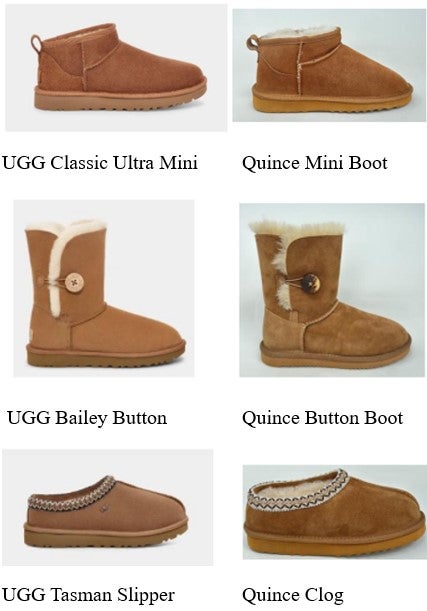UGG-ly Result: Court Calls Classic Ultra Mini and Tasman Trade Dress Generic, Design Patent Survives
On June 12, 2023, Deckers Outdoor Corporation, owner of the UGG brand, sued Quince, an affordable fashion e-commerce company, alleging that Quince’s shearling lined boots infringed Deckers’ unregistered trade dress and one design patent (US Patent D927,161) (the “’161 Patent”) covering one of its most popular boots, the Classic Ultra Mini Boot.
The litigation later expanded to include Decker’s trade dress claims for additional styles, namely the Bailey Button Boot and the Tasman Slipper. Deckers claimed each design comprised non-functional and protectable features. For example, for the Classic Ultra Mini, it noted its ankle-high suede construction with a top line higher in the front and lower in the back, and for the Tasman, a distinctive embroidered braid around the opening of the upper.


Procedural Posture and Parties’ Arguments
Quince answered with affirmative defenses of functionality, lack of distinctiveness, and genericness of the trade dresses and invalidity of the design patent. Both parties moved for summary judgment.
Deckers moved for summary judgment on its trade dress claims, arguing the asserted designs were nonfunctional and that alternative designs existed. Deckers emphasized that product designs are not deemed functional merely because they contain functional elements and asserted none of the three asserted trade dresses conferred a utilitarian advantage over other boots or clogs. Deckers offered declarations addressing available alternative designs and cited secondary meaning evidence, including commercial success, widespread knockoffs, celebrity recognition, and consumer surveys. Deckers also described Quince’s business model as focused on copying trending styles, submitting a declaration that Quince lacks in-house footwear designers and “uses images of these high revenue driving styles as a base to copy.”
Quince moved for partial summary judgment, contending the UGG Classic Ultra Mini and Tasman trade dress claims fail because the designs were generic in the footwear industry and did not identify a single source. Quince further challenged the design patent on functionality and indefiniteness grounds, arguing features like ankle-high suede construction and exposed stitching are common features in sheepskin footwear. Quince presented evidence that at least 14 competitors sell boots similar to the asserted Classic Ultra Mini and nine competitors sell slippers similar to the Tasman.
The Court’s Decision
The Northern District of California ruled in Quince’s favor on the trade dress claims for the Classic Ultra Mini and Tasman, finding the designs unprotectable as generic. The court concluded Deckers’ failed to carry its burden to prove non-genericness, finding that its arguments “do not hold water.” The court rejected, as being without authority, Deckers’ contentions that the distinctiveness of its designs could be demonstrated by the fact that no closely resembling products were sold before it launched them and that each of the identified competitors entered the market after UGG popularized the designs. Deckers was also criticized for providing no authority to support requiring Quince to show where competitor goods were sold, in what quantities, or “whether they were knockoffs.” The court also observed Deckers did not otherwise dispute that the competitor footwear Quince identified was properly considered in assessing genericness.
Separately, the court found Deckers failed to address the aesthetic functionality requirement. The court explained that in their view if a design serves an aesthetic purpose, independent of source identification, and exclusive rights would meaningfully disadvantage competitors, the design has aesthetic functionality and is not protectable as trade dress. The court reiterated the basic principle that trademark law cannot protect a trade dress that is either utilitarian or aesthetically functional. Against this backdrop, some courts look to whether effective alternative designs exist and whether competitors need the design to compete; however, we note this is an approach applied unevenly across jurisdictions.
While dismissing Deckers’ trade dress claims for the Classic Ultra Mini and Tasman, the court declined to invalidate the ‘161 Patent on functionality and indefiniteness grounds and allowed the infringement claim and the Bailey Button trade dress claim to proceed. Quince did not meet the clear and convincing burden to prove (1) functionality, as the court found Quince’s “brief treatment” on the topic insufficient, or (2) indefiniteness, as the court concluded that boot designers and manufacturers could determine from the patent the overall claimed appearance with reasonable certainty. The court, consistent with longstanding precedent in this area, declined to conduct a written claim construction. The ‘161 Patent, thus, lives to fight another day.
Practical Considerations
This decision, which is likely to be appealed by both sides, highlights the challenge of enforcing unregistered trade dress in widely copied footwear categories that blend functional and non-functional elements, even where the brand owner enjoys long-term commercial success and consumer recognition.
Due consideration of forum selection is essential to the enforcement of trade dress, and the optimal forum can vary by industry. For example, courts apply aesthetic functionality tests (often implicated in fashion cases) inconsistently, and there is no clear US Supreme Court guidance. Thus, forum choice can materially affect the viability of a trade dress claim.
Pursue multiple intellectual property avenues when it comes to the appearance of products. Brands should avoid relying solely on unregistered trade dress to protect their product designs. A layered strategy that includes design patents, unregistered and registered trade dress, copyright, and 3D trademarks provides complementary tools to deter and enforce against imitators.
Proactively enforce and curate the record. The court criticized Deckers for failing to engage the aesthetic functionality inquiry, despite offering alternative design evidence, while Quince marshaled marketplace evidence of numerous similar products for its own arguments. Active, consistent enforcement that reduces marketplace saturation of infringements can strengthen arguments against genericness and in favor of protectability.
ArentFox Schiff will continue to monitor developments in this area and provide updates as warranted.
This case is Deckers Outdoor Corp. v. Last Brand, Inc.,3:23-cv-04850 (N.D. Cal.).
Contacts
- Related Industries
- Related Practices

